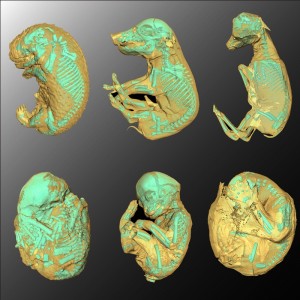Cranial development and brain evolution Development of the skull reflects brain size evolution

Some 6,000 species of mammal live throughout the world in a variety of environments on the land, in the sea and in the sky. Mammalian morphology reflects this ecological diversity, and it is possible that one of the factors that has driven this diversity is the remarkable changes in fetal growth during the process of mammalian evolution. However, the progress of mammalian fetal growth in the womb is little known other than in experimental animals such as mice and guinea pigs and livestock such as pigs and cows. How fetal growth differs between species and how that difference relates to interspecies differences in form remains unclear.

© Daisuke Koyabu.
CT scans of embryos of various mammals. From the top left, a hedgehog, boar, deer, bat, macaque monkey, and colugo.
An international research group lead by Project Assistant Professor Daisuke Koyabu from the Museum Group for Promoting Cutting-Edge Research in Macroscopic Sciences, the University Museum, the University of Tokyo and including researchers from Japan, Switzerland, Germany, Argentina, South Korea and Vietnam, gathered a vast collection of fetal specimens from each country covering 102 species representative of all mammals throughout the world, and have shown that the timing of cranial formation and the evolution of cranial diversity in mammals is strongly correlated with the evolution of mammalian brain size (encephalization). Specifically, it was also found that the timing of skull-roof bone formation was earlier for species with larger brains as a proportion of body weight. In addition, the researchers also showed how fetal development of the human skull differs from that of other mammals.
Building on the basis of these discoveries, it is hoped that future research will identify the genetic basis governing changes in the timing of bone formation and what genetic changes have occurred in the history of evolution of the human brain, leading to an understanding of how the schedule of development of the head has changed and how the human brain came to be so large.
This research was published in the journal Nature Communications on Friday, 4 April 2014
Paper
Daisuke Koyabu, Ingmar Werneburg, Naoki Morimoto, Christoph P.E. Zollikofer, Analia M. Forasiepi, Hideki Endo, Junpei Kimura, Satoshi D. Ohdachi, Son Nguyen Truong, Marcelo R. Sanchez-Villagra,
“Mammalian skull heterochrony reveals modular evolution and a link between cranial development and brain size”,
Nature Communications Online Edition: 2014/4/4, doi: 10.1038/ncomms4625.
Article link






